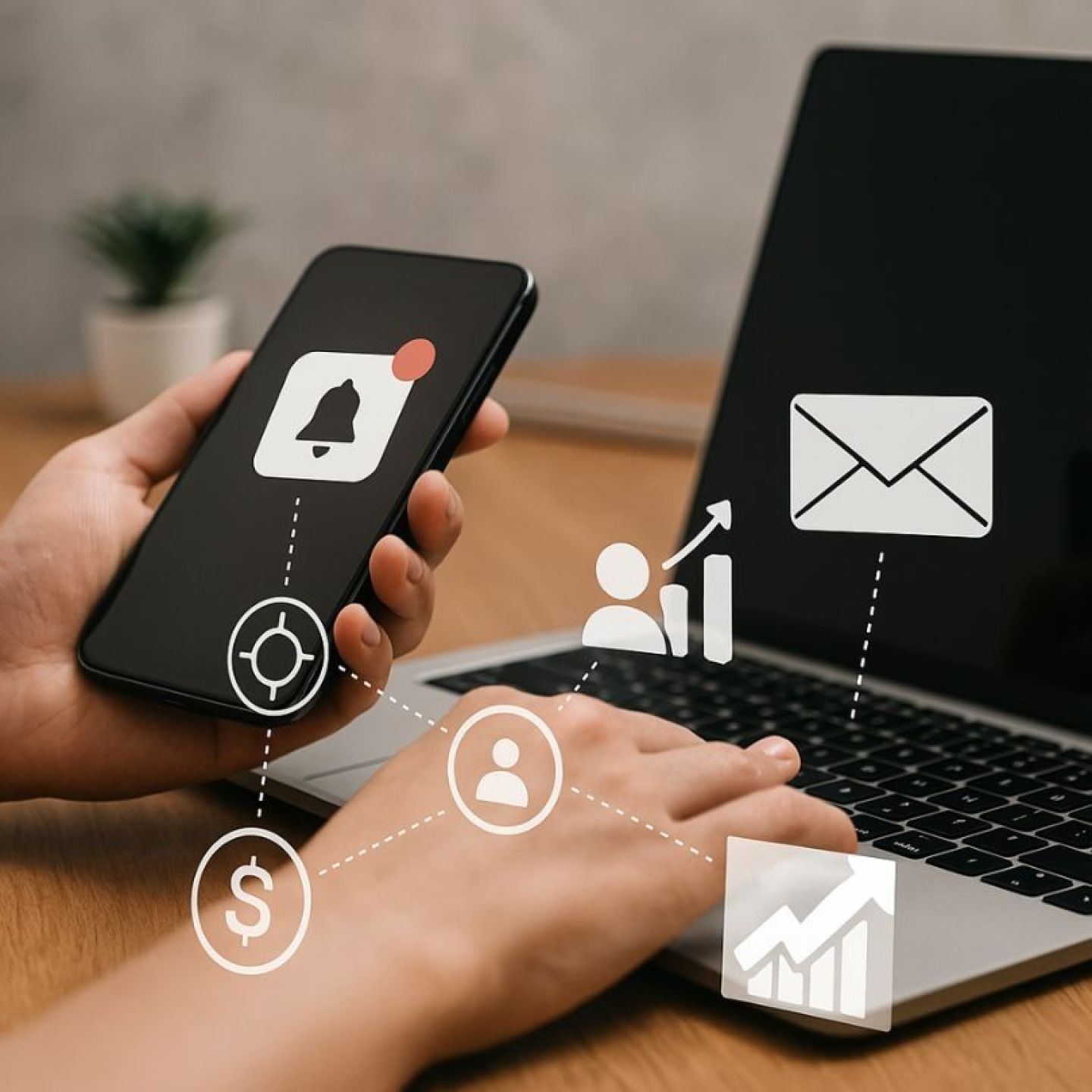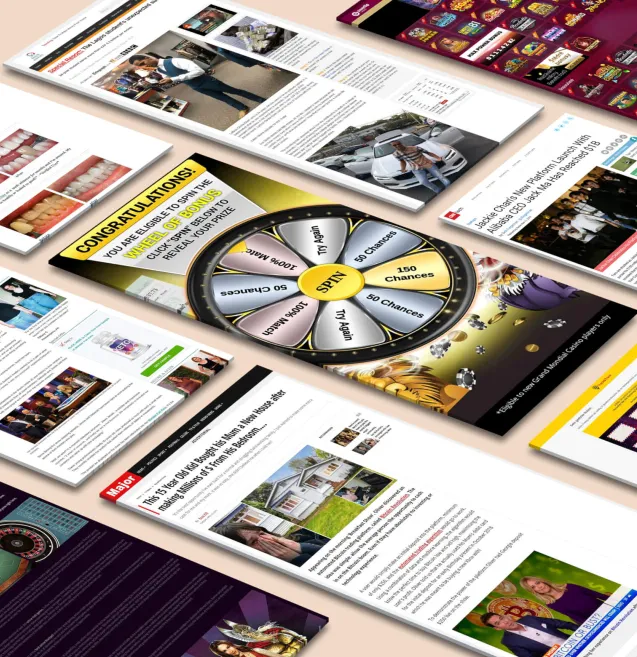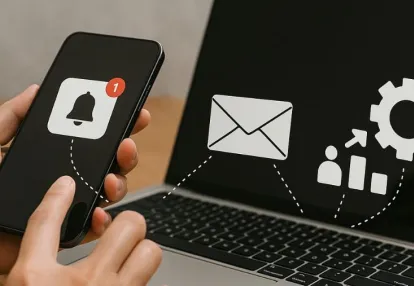
Наши инструменты отслеживают миллионы рекламных кампаний в форматах native, push, pop и TikTok.
НачатьIf you're treating push notifications and email marketing as separate things, you're missing out on potential revenue. Combining push ads with email for consistent conversions isn't just a trendy approach—it's the key to turning unpredictable results into steady income growth.
Here's the truth: your customers don't stick to just one channel. They check their email in the morning, use your app during lunch, and respond to notifications throughout the day. By implementing integrated push and email strategies, you can reach them wherever they are, precisely when they're most likely to engage.
The biggest challenge that many marketers encounter is inconsistent conversion rates. One week, your campaigns might perform exceptionally well, but the next week, they could flop completely. This unpredictability often comes from relying too much on one digital marketing channel while overlooking the potential benefits of using multiple touchpoints together.
The solution to this problem lies in the synergy between push notifications and emails. This combination creates a backup plan for communication. When your email gets lost in someone's inbox, your push notification stands out and grabs their attention. If a user dismisses a notification, your follow-up email provides all the necessary details they need to convert.
For those looking to enhance their email campaign conversions, there are several strategies that can be implemented:
The brands that achieve the most consistent conversions aren't necessarily using more channels—they're simply using them together. By implementing integrated push and email campaigns, you can send coordinated messages that reinforce your unique value proposition and guide users smoothly toward conversion.
Before you can harness the power of integrated campaigns, you need to understand what makes each channel unique. Push ads and email marketing serve different purposes in your conversion strategy, and recognizing their individual strengths helps you deploy them effectively.
Push notifications are short, clickable messages that appear directly on users' devices—whether they're browsing your website or using your mobile app. These messages pop up in real-time, cutting through the digital noise to grab immediate attention.
The defining characteristic of push notifications is their immediacy. When you send a push notification, it appears within seconds on your user's screen. This instant delivery makes them perfect for time-sensitive messages where timing directly impacts conversion rates.
You'll find that push notifications boast impressive engagement metrics:
Ideal use cases where push notifications excel include:
The brevity of push notifications—typically under 100 characters—forces you to craft concise, compelling messages with strong calls to action. You're not explaining complex concepts; you're creating urgency and driving clicks.
The risk of user fatigue represents the biggest challenge with push notifications. Send too many, and users will disable notifications or uninstall your app entirely. Best practices to avoid this include limiting frequency to 2-3 messages per week, ensuring every notification provides genuine value, respecting user preferences and quiet hours, and segmenting audiences to send only relevant messages to specific user groups.
Email marketing serves as your detailed communication powerhouse, reaching 4.48 billion users globally. Unlike the brevity of push notifications, email gives you the space to craft comprehensive messages that educate, inform, and persuade your audience through rich multimedia content.
You can leverage email for multiple purposes across the customer journey:
The broad reach of email marketing comes with significant obstacles you need to navigate. Spam filters increasingly scrutinize incoming messages, causing legitimate marketing emails to land in junk folders where they'll never see the light of day. Your subscribers face message overload—the average person receives 121 emails daily, making it harder for your content to stand out in crowded inboxes.
Delayed engagement presents another challenge. Unlike push notifications that demand immediate attention, emails often sit unread for hours or days. Users check their inboxes on their own schedule, which means your time-sensitive messages might arrive too late to drive action. This delayed response makes email less effective for urgent communications like flash sales or abandoned cart reminders that require quick user responses.
If you're only using one way to reach your audience, you're missing out on potential conversions. The truth is, your users have different preferences and habits when it comes to consuming content. Some people check their email every morning without fail, while others ignore notifications completely. This is where an omnichannel experience becomes really useful.
When you combine push notifications with email marketing, you're creating a cross channel conversion strategy that doesn't rely on users interacting with just one point of contact. Instead, you're creating multiple chances to grab their attention and encourage them to take action. For example, if someone misses your email because it ended up in their promotions folder, your push notification can act as a second reminder that brings them back to complete their purchase.
The strength of multi channel marketing automation is its ability to reach a larger audience without doing extra work. You're not simply sending the same message twice—you're strategically placing your brand across different channels where your users naturally spend their time.
Here's what happens when you combine these channels:
Each channel makes up for the weaknesses of the other. Email might get lost among many other messages, but your push notification stands out with immediate visibility. Your push notification might be ignored in a moment of distraction, but your email stays in the inbox as a constant reminder.
This cross channel conversion strategy ensures you're reaching users where they are, at the times when they're most open to hearing your message.
Behavior-based campaigns transform your omnichannel experience from generic broadcasts into intelligent conversations with your users. You can use data to trigger coordinated push and email messages based on specific user actions, creating a cross channel conversion strategy that responds to real-time behavior.
Here's how this works in practice: when a user abandons their shopping cart, your multi channel marketing automation system can send a detailed email within an hour showcasing the items they left behind, complete with product images and descriptions. If that email goes unopened after 24 hours, you follow up with a push notification—a short, urgent reminder that appears directly on their device: "Your cart is waiting! Complete your purchase now and save 10%."
This sequential approach through personalized messaging respects the user's preferred communication style while maximizing your chances of conversion. Some users respond better to the detailed information in emails, while others need the immediate visibility of push notifications.
You can apply this same principle to various scenarios:
Combining push ads with email for consistent conversions means you're meeting users where they are, when they're ready to engage.
When you're running campaigns across multiple touchpoints, branding cohesion becomes your competitive advantage. Users interact with your brand through different channels throughout their day, and each interaction shapes their perception of who you are and whether they can trust you.
A successful omnichannel experience requires uniform design elements and messaging that users instantly recognize. Your push notifications should mirror the visual identity of your emails—same color schemes, similar typography, matching brand voice. When a user receives an email about a product launch and later sees a push notification about the same offer, they should immediately connect the two messages as coming from the same trusted source.
This cross channel conversion strategy builds recognition through repetition and consistency. You're not just sending messages; you're creating a cohesive brand narrative that follows users across their digital journey. The tone you use in your push notifications should align with your email copy. If your emails are conversational and friendly, your push messages need that same warmth. If your brand voice is professional and authoritative, maintain that standard across both channels.
Multi channel marketing automation tools make this consistency achievable at scale. You can establish brand guidelines within your automation platform, ensuring every message—whether push or email—adheres to your visual and tonal standards. This unified approach doesn't just look professional; it directly impacts conversion rates because users develop confidence in your brand's reliability and authenticity.
To effectively combine push ads with email for consistent conversions, you need powerful multi channel marketing automation tools. These tools can manage complex workflows without manual effort, understanding how different touchpoints are connected and triggering the right message at the right time based on user behavior.
Pushwoosh's Customer Journey Builder is a great example of how modern multi channel marketing automation tools make it easier to create sophisticated campaigns. With its visual interface, you can build workflows by simply dragging and dropping elements, seamlessly integrating push notifications and emails. This eliminates the need for complicated coding or separate systems to manage campaigns.
Here's how you can structure integrated campaigns using this type of automation tool:
Welcome Series with Progressive Engagement:
Abandoned Cart Recovery Sequence:
The beauty of multi channel marketing automation tools lies in their ability to track user responses across channels. If a user opens your email and clicks through, the system automatically cancels the subsequent push notification. This intelligent orchestration prevents message redundancy while maximizing your chances of conversion through strategic touchpoint sequencing.
Audience segmentation transforms generic campaigns into precision-targeted communications that speak directly to user needs. When you segment your audience based on behavior patterns, demographics, purchase history, and engagement levels, you create opportunities for combining push ads with email for consistent conversions that actually resonate.
Multi-channel marketing automation tools like Pushwoosh's Customer Journey Builder enable sophisticated segmentation strategies that power both push notifications and email campaigns simultaneously. You can divide your audience into meaningful groups:
The impact of proper audience segmentation on conversion rates is substantial. A first-time visitor browsing winter coats receives different messaging than a returning customer who previously purchased summer apparel. You send the newcomer an introductory email series paired with gentle push reminders, while the returning customer gets personalized recommendations through both channels based on their shopping patterns.
Segmented campaigns consistently outperform one-size-fits-all approaches because they deliver relevant content at the right moment. When you match message content to user intent and stage in the customer journey, you eliminate the noise that causes users to disengage from your communications entirely.
You've segmented your audience perfectly, but sending messages at the wrong time or too frequently can destroy your conversion potential. Message timing optimization is where many marketers fail—they either bombard users with notifications or send them when engagement is lowest.
Multi channel marketing automation tools like Pushwoosh's Customer Journey Builder solve this challenge by letting you schedule coordinated campaigns based on user behavior patterns. You can set specific time windows when your audience is most active, ensuring your push notifications arrive during peak engagement hours while emails land in inboxes when users typically check them.
The key to combining push ads with email for consistent conversions lies in strategic spacing:
You need to establish frequency caps in your automation tools. I recommend limiting push notifications to 2-3 per week maximum, while emails can range from 3-5 depending on user preferences. Track unsubscribe rates and notification opt-outs religiously—spikes indicate you're pushing too hard.
Test different time intervals between messages. Some users respond better to a push notification 6 hours after an unopened email, while others need 48 hours. Your automation platform's analytics will reveal these patterns.
You can't improve what you don't measure. A/B testing is your most reliable method for understanding which combinations of push notifications and emails drive the highest conversion rates. When combining push ads with email for consistent conversions, testing becomes even more critical because you're managing multiple variables across two distinct channels.
Start by testing one element at a time. You might experiment with different subject lines in your emails while keeping the push notification copy identical, or test various push notification timings while maintaining the same email content. This isolated approach helps you identify exactly which changes impact your results.
Key Elements to Test in Your Integrated Campaigns:
You'll want to run tests with statistically significant sample sizes. A common mistake is ending tests too early or with too few participants. Aim for at least 1,000 users per variation when possible, and let your tests run for a minimum of 3-7 days to account for different user behavior patterns throughout the week.
Split testing your audience segments reveals powerful insights. Your younger users might respond better to push notifications sent in the evening, while your older demographic prefers morning emails. You can't assume one strategy works universally across all user groups.
Track metrics that matter for your specific goals. If you're focused on immediate conversions, monitor click-through rates and purchase completion within the first hour. For longer sales cycles, track engagement over several days and measure how the combination of channels influences the final conversion decision.
Document your A/B testing results in a centralized dashboard. You'll build a knowledge base of what works for your specific audience, allowing you to refine your integrated push and email strategy continuously.
You need to recognize that most users interact with both push notifications and emails on mobile devices. Your conversion rates depend heavily on how well your content displays and functions on smaller screens.
Combining Push Ads with Email for Consistent Conversions requires mobile-first design principles:
A/B testing becomes critical when optimizing for mobile:
Your images need compression without quality loss to ensure fast loading times. You want to avoid horizontal scrolling in emails and ensure all clickable elements are easily tappable. Test your campaigns across different devices and email clients—what works on an iPhone might display differently on Android devices. This attention to mobile optimization directly impacts your ability to maintain consistent conversions across both channels.
Combining Push Ads with Email for Consistent Conversions requires a unified content strategy where both channels work in harmony rather than competition. You need to map out how each message type serves a specific purpose in your customer journey.
Your push notifications should deliver the immediate, attention-grabbing headlines while your emails provide the detailed context and comprehensive information. Think of push notifications as the appetizer that creates urgency—"24-hour flash sale ends tonight!"—while your email serves as the main course with product details, customer reviews, and multiple purchase options.
A/B testing becomes critical when coordinating content across channels. You can test different message sequences to discover what resonates:
The key to Combining Push Ads with Email for Consistent Conversions lies in maintaining thematic consistency while adapting format to each channel's strengths. If you're promoting a product launch, your push notification might highlight the exclusive early access while your email showcases the full product lineup with specifications, pricing tiers, and customer testimonials. Both messages share the same visual branding, color scheme, and promotional offer code, creating a seamless experience that reinforces your message regardless of where users encounter it.
You can't improve what you don't measure. When you're running integrated push and email campaigns, tracking the right metrics becomes your roadmap to understanding what's working and what needs adjustment.
The real power comes from tracking cross-channel metrics that show how these channels work together. You want to measure attribution across both channels to understand which touchpoint deserves credit for conversions. Did the email introduce the offer while the push notification sealed the deal? Or did the push notification create initial awareness that the email then converted?
Tools like Pushwoosh provide unified analytics dashboards where you can view performance data from both channels side by side. You'll see patterns emerge—maybe your push notifications drive immediate action while emails generate higher-value purchases. Perhaps users who engage with both channels have a 3x higher conversion rate than single-channel users.
Track these metrics weekly at minimum. Monthly
The metrics you've been tracking reveal patterns that show you exactly where to invest more resources. When you notice certain segments responding exceptionally well to combining push ads with email for consistent conversions, you can replicate that success across similar audience groups.
Start by identifying your highest-performing campaign sequences. If a particular workflow—say, an email followed by a push notification 24 hours later—drives 40% more conversions than standalone messages, you've found your scaling blueprint. Duplicate this structure for other product categories or user segments.
Your data might reveal that users who engage with both channels within the first week have 3x higher lifetime value. This insight tells you to prioritize getting new users opted into both channels immediately. Adjust your onboarding flows accordingly, making dual opt-ins seamless and valuable.
Budget allocation becomes straightforward when you know which channel drives initial awareness and which closes the sale. If emails generate interest but push notifications seal the deal, you can confidently increase your push notification frequency for engaged segments while maintaining email nurture sequences.
Test expansion into new segments using your proven formulas. Apply the same timing, messaging cadence, and content structure that worked for one demographic to another. The beauty of integrated strategies is that successful patterns transfer across audiences when you maintain the core principles that drove the original results.
Получайте лучшие конверсионные лендинги каждую неделю на свою почту.
Советы и хитрости
Liam O’Connor
7 миннояб. 15, 2025
Обязательно к прочтению
Push-уведомления стали одним из самых прямых и эффективных инструментов маркетинга для удержания клиентов. Эти короткие сообщения с изображениями или видео поступают прямо на устройства ваших клиентов, создавая немедленные возможности напомнить им о вашем бренде. В отличие от электронных писем, которые зачастую остаются непрочитанными в переполненных почтовых ящиках, push-уведомления привлекают внимание с средней частотой открытия 90% по сравнению с 20% для электронной почты.
David Kim
7 миннояб. 9, 2025
Коротко
Данные первой стороны — информация, которую вы собираете непосредственно от своих клиентов через посещения сайта, взаимодействия с приложением и историю покупок — стали краеугольным камнем эффективной рекламы через push-уведомления. Эти данные поступают напрямую от вашей аудитории с их явного согласия, что делает их этически обоснованными и чрезвычайно ценными для создания персонализованных маркетинговых кампаний.
Priya Kapoor
7 минокт. 28, 2025




